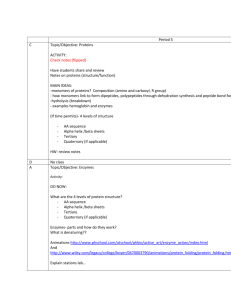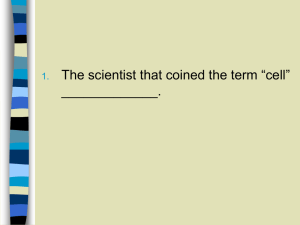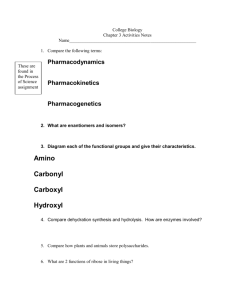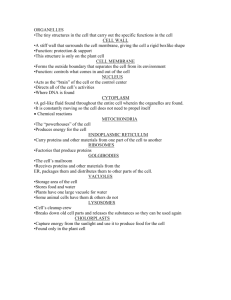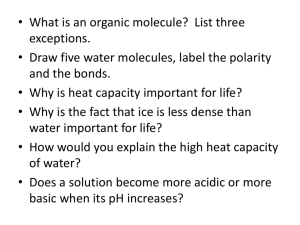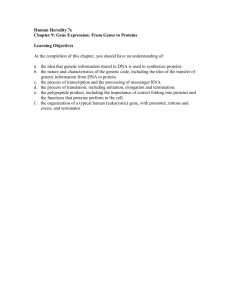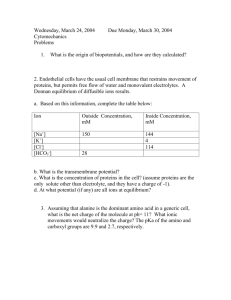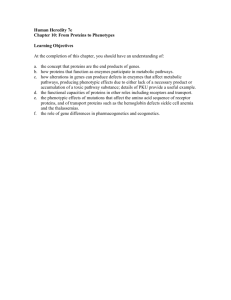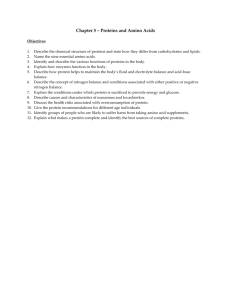CS273_StructurePrediction
advertisement
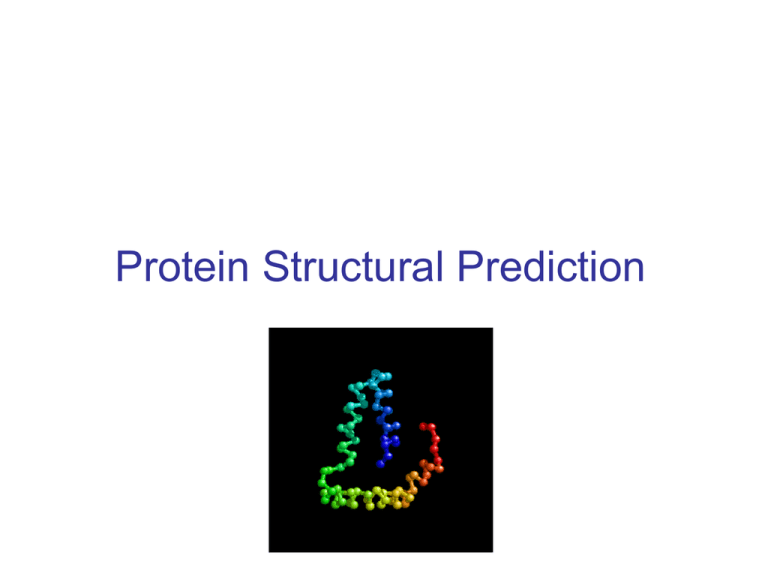
Protein Structural Prediction Protein Structure is Hierarchical Structure Determines Function The Protein Folding Problem What determines structure? • • Energy Kinematics How can we determine structure? • • Experimental methods Computational predictions Primary Structure: Sequence • The primary structure of a protein is the amino acid sequence Primary Structure: Sequence • Twenty different amino acids have distinct shapes and properties Primary Structure: Sequence A useful mnemonic for the hydrophobic amino acids is "FAMILY VW" Secondary Structure: , , & loops • helices and sheets are stabilized by hydrogen bonds between backbone oxygen and hydrogen atoms Secondary Structure: helix Secondary Structure: sheet sheet buldge Second-and-a-half-ary Structure: Motifs beta helix beta barrel beta trefoil Tertiary Structure: Domains Mosaic Proteins Tertiary Structure: A Protein Fold Protein Folds Composed of , , other Quaternary Structure: Multimeric Proteins or Functional Assemblies • Multimeric Proteins • Macromolecular Assemblies Ribosome: Protein Synthesis Hemoglobin: A tetramer Replisome: DNA copying Protein Folding • The amino-acid sequence of a protein determines the 3D fold [Anfinsen et al., 1950s] Some exceptions: All proteins can be denatured Some proteins have multiple conformations Some proteins get folding help from chaperones • The function of a protein is determined by its 3D fold • Can we predict 3D fold of a protein given its amino-acid sequence? The Leventhal Paradox • Given a small protein (100aa) assume 3 possible conformations/peptide bond • 3100 = 5 × 1047 conformations • Fastest motions 10- 15 sec so sampling all conformations would take 5 × 1032 sec • 60 × 60 × 24 × 365 = 31536000 seconds in a year • Sampling all conformations will take 1.6 × 1025 years • Each protein folds quickly into a single stable native conformation the Leventhal paradox Quick Overview of Energy Bond Strength (kcal/mole) H-bonds 3-7 Ionic bonds 10 Hydrophobic interactions 1-2 Van der vaals interactions 1 Disulfide bridge 51 The Hydrophobic Effect • Important for folding, because every amino acid participates! 2.25 Trp 0.26 Thr 1.80 Ile 0.13 His 1.79 Phe 0.00 Gly 1.70 Leu -0.04 Ser 1.54 Cys -0.22 Gln 1.23 Met -0.60 Asn 1.22 Val -0.64 Glu 0.96 Tyr -0.77 Asp 0.72 Pro -0.99 Lys 0.31 Ala -1.01 Arg Experimentally Determined Hydrophobicity Levels Fauchere and Pilska (1983). Eur. J. Med. Chem. 18, 369-75. Protein Structure Determination • Experimental X-ray crystallography NMR spectrometry • Computational – Structure Prediction (The Holy Grail) Sequence implies structure, therefore in principle we can predict the structure from the sequence alone Protein Structure Prediction • ab initio Use just first principles: energy, geometry, and kinematics • Homology Find the best match to a database of sequences with known 3Dstructure • Threading • Meta-servers and other methods Ab initio Prediction • Sampling the global conformation space Lattice models / Discrete-state models Molecular Dynamics Pre-set libraries of fragment 3D motifs • Picking native conformations with an energy function Solvation model: how protein interacts with water Pair interactions between amino acids • Predicting secondary structure Local homology Fragment libraries Lattice String Folding • HP model: main modeled force is hydrophobic attraction NP-hard in both 2-D square and 3-D cubic Constant approximation algorithms Not so relevant biologically Lattice String Folding ROSETTA http://www.bioinfo.rpi.edu/~bystrc/hmmstr/server.php http://depts.washington.edu/bakerpg/papers/Bonneau-ARBBS-v30-p173.pdf • Monte Carlo based method • Limit conformational search space by using sequence—structure motif I-Sites library (http://isites.bio.rpi.edu/Isites/) 261 patterns in library Certain positions in motif favor certain residues • Remove all sequences with <25% identity • Find structures of the 25 nearest sequence neighbors of each 9-mer Rationale Local structures often fold independently of full protein Can predict large areas of protein by matching sequence to ISites ? ? ? I-Sites Examples • Non polar helix Abundance of alanine at all positions Non-polar side chains favored at positions 3, 6, 10 (methionine, leucine, isoleucine) • Amphipathic helix Non-polar side chains favored at positions 6, 9, 13, 16 (methionine, leucine, isoleucine) Polar side chains favored at positions 1, 8, 11, 18 (glutamic acid, lysine) ROSETTA Method • • • • New structures generated by swapping compatible fragments Accepted structures are clustered based on energy and structural size Best cluster is one with the greatest number of conformations within 4-Å rms deviation structure of the center Representative structures taken from each of the best five clusters and returned to the user as predictions ? ? ? Robetta & Rosetta Rosetta results in CASP Rosetta Results • In CASP4, Rosetta’s best models ranged from 6–10 Å rmsd C • For comparison, good comparative models give 2-5 Å rmsd C • Most effective with small proteins (<100 residues) and structures with helices Only a few folds are found in nature The SCOP Database Structural Classification Of Proteins FAMILY: proteins that are >30% similar, or >15% similar and have similar known structure/function SUPERFAMILY: proteins whose families have some sequence and function/structure similarity suggesting a common evolutionary origin COMMON FOLD: superfamilies that have same secondary structures in same arrangement, probably resulting by physics and chemistry CLASS: alpha, beta, alpha–beta, alpha+beta, multidomain Status of Protein Databases PDB SCOP: Structural Classification of Proteins. 1.67 release 24037 PDB Entries (15 May 2004). 65122 Domains. Class EMBL Number of folds Number of superfamilies Number of families All alpha proteins 202 342 550 All beta proteins 141 280 529 Alpha and beta proteins (a/b) 130 213 593 Alpha and beta proteins (a+b) 260 386 650 Multi-domain proteins 40 40 55 Membrane and cell surface proteins 42 82 91 Small proteins 71 104 162 Total 887 1447 2630 Evolution of Proteins – Domains Chothia, Gough, Vogel, Teichmann, Science 300:1701-17-3, 2003 #members in different families obey power law 429 families common in all 14 eukaryotes; 80% of animal domains, 90% of fungi domains 80% of proteins are multidomain in eukaryotes; domains usually combine pairwise in same order --why? Evolution of proteins happens mainly through duplication, recombination, and divergence Homology-based Prediction • Align query sequence with sequences of known structure, usually >30% similar • Superimpose the aligned sequence onto the structure template, according to the computed sequence alignment • Perform local refinement of the resulting structure in 3D The number of unique structural folds is small (possibly a few thousand) 90% of new structures submitted to PDB in the past three years have similar folds in PDB Examples of Fold Classes Homology-based Prediction Raw model Loop modeling Side chain placement Refinement Homology-based Prediction
